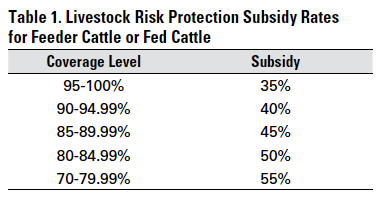Empower Your Company: Bagley Risk Management Insights
Comprehending Livestock Danger Security (LRP) Insurance Coverage: A Comprehensive Guide
Browsing the world of livestock danger defense (LRP) insurance can be an intricate endeavor for many in the agricultural industry. From exactly how LRP insurance coverage operates to the numerous coverage alternatives available, there is much to uncover in this comprehensive overview that could potentially shape the means animals manufacturers approach risk monitoring in their organizations.

Exactly How LRP Insurance Works
Sometimes, understanding the mechanics of Animals Danger Protection (LRP) insurance policy can be complicated, but damaging down how it functions can offer quality for farmers and herdsmans. LRP insurance is a risk monitoring tool designed to secure livestock producers versus unforeseen rate declines. The plan allows producers to establish a coverage degree based on their certain needs, selecting the variety of head, weight range, and insurance coverage price. When the plan is in location, if market rates fall below the insurance coverage price, producers can submit a claim for the distinction. It is very important to note that LRP insurance policy is not a revenue warranty; rather, it focuses entirely on cost threat security. The coverage period usually varies from 13 to 52 weeks, providing versatility for manufacturers to choose a duration that lines up with their manufacturing cycle. By using LRP insurance policy, breeders and farmers can alleviate the economic risks related to changing market value, guaranteeing higher stability in their operations.
Eligibility and Protection Options

When it comes to insurance coverage alternatives, LRP insurance offers producers the adaptability to pick the insurance coverage degree, insurance coverage duration, and recommendations that best suit their threat management needs. By comprehending the eligibility standards and protection choices readily available, animals producers can make informed choices to handle risk successfully.
Advantages And Disadvantages of LRP Insurance
When reviewing Animals Danger Defense (LRP) insurance, it is important for animals manufacturers to weigh the benefits and downsides intrinsic in this risk monitoring tool.

One of the main benefits of LRP insurance is its ability to supply security against a decline in livestock costs. Furthermore, LRP insurance coverage uses a degree of versatility, permitting manufacturers to tailor insurance coverage degrees and plan durations to fit their particular requirements.
Nevertheless, there are likewise some disadvantages to think about. One limitation of LRP insurance is that it does not protect against all kinds of threats, such as illness break outs or natural calamities. In addition, costs can in some cases be costly, especially for manufacturers with huge livestock herds. It is critical for producers to meticulously evaluate their individual risk exposure and economic circumstance to figure out if LRP insurance is the best risk monitoring tool for their procedure.
Comprehending LRP Insurance Premiums

Tips for Making The Most Of LRP Perks
Maximizing the benefits of Livestock Danger Defense (LRP) insurance calls for critical planning and proactive danger monitoring - Bagley Risk Management. To maximize your LRP coverage, take into consideration the complying with ideas:
Consistently Analyze Market Conditions: Stay informed about market trends and cost changes in the livestock market. By checking these aspects, you can make educated decisions regarding when to purchase LRP coverage to protect versus possible losses.
Establish Realistic Insurance Coverage Degrees: When choosing protection levels, consider your manufacturing prices, market price of animals, and possible dangers - Bagley Risk Management. Setting realistic coverage degrees makes certain that you are sufficiently secured without overpaying for unneeded insurance policy
Expand Your Protection: As opposed to counting exclusively on LRP insurance visit here coverage, think about expanding your risk management strategies. Combining LRP with various other danger administration tools such as futures contracts or options can provide comprehensive coverage versus market uncertainties.
Review and Change Coverage Routinely: As market conditions transform, regularly examine your LRP coverage to ensure it aligns with your present risk direct exposure. Readjusting insurance coverage levels and timing of acquisitions can help maximize your risk security strategy. By complying with these tips, you can make the most of the advantages of LRP insurance coverage and guard your livestock procedure versus unexpected threats.
Conclusion
In final thought, animals risk security (LRP) insurance policy is a valuable tool for farmers to take care my latest blog post of the financial dangers connected with their livestock operations. By comprehending just how LRP functions, eligibility and protection alternatives, as well as the benefits and drawbacks of this insurance policy, farmers can make informed choices to safeguard their source of incomes. By meticulously thinking about LRP costs and applying strategies to take full advantage of advantages, farmers can reduce prospective losses and make sure the sustainability of their operations.
Animals producers interested in acquiring Animals Threat Defense (LRP) insurance policy can discover an array of qualification standards and coverage alternatives customized to their certain animals procedures.When it comes to protection choices, LRP insurance coverage uses manufacturers the versatility to select the coverage level, coverage duration, and recommendations that finest suit their risk management demands.To grasp the intricacies of Animals Danger Defense (LRP) insurance policy completely, recognizing the variables affecting LRP insurance policy costs is vital. LRP insurance coverage costs are determined by different components, consisting of the insurance coverage degree picked, the anticipated rate of animals at the end of the coverage duration, the kind of read the full info here animals being guaranteed, and the length of the insurance coverage period.Review and Readjust Coverage Routinely: As market conditions change, periodically assess your LRP protection to guarantee it lines up with your current threat exposure.